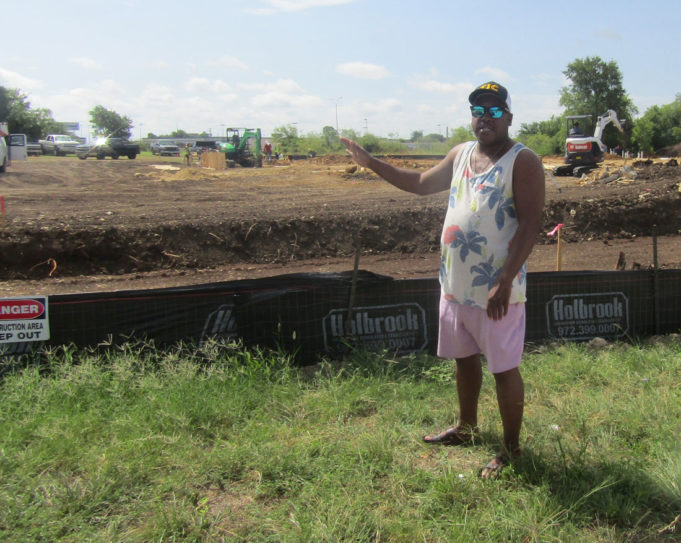A dollar here and a dollar there, and pretty soon you’re talking about nearly 100 dollar-type stores across east and southeast Fort Worth.
All of those dollars are adding up to a lot of frustration for residents who believe the stores are multiplying too quickly and are crowding out retailers and grocery stores that sell healthier food. Other communities in Texas and across the country are also trying to rein in the proliferation of dollar-type stores by putting new zoning regulations in place.
The Rolling Hills area in southeast Fort Worth is just one of the neighborhoods dealing with dollar stores that seem to be popping up on almost every corner. Residents said they were surprised when construction crews recently began clearing an empty lot at the corner of Riverside and Campus drives and were even more surprised to learn that a Family Dollar store was being built at the busy intersection.
Within a three-mile radius of the neighborhood, there are already 19 dollar-type stores, according to figures provided by the office of District 8 Councilmember Kelly Allen Gray. The entire district has at least 75 of them. That includes 37 Family Dollars, 20 Dollar Generals, 15 Dollar Trees, two 99 Cent Only stores, and one 99 Cent store.
Critics say the stores create “food deserts” – areas lacking businesses with healthy foods like fresh fruits and vegetables.
“The dollar stores have so much processed food and no healthy choices,” said LaShanda Davis, president of Glencrest Civic League. “I’m not sure where the city is going with this and how are we benefiting from that.”
The growing number of dollar stores seems to counter the city’s Blue Zones Project, which encourages a healthier lifestyle, she added. “I know we have the walking trails and the bike trails, but what about the food?” Davis said.
Walk into any dollar store, and you’ll find a plethora of salty, sugary, high-calorie options: frozen pizza, canned ravioli, chips, cookies, and candy. Family Dollar admittedly serves “low- to middle-income customers,” according to its website. The Institute for Local Self Reliance, a nonprofit community advocacy group, reports that the company also targets neighborhoods that are predominately African-American.
Terrence Watson, president of the Glen Eden Neighborhood Association, said residents protested the store, but the project was already approved. A private developer owns the land and was able to get the store in under existing zoning laws.
Last week, construction crews for Family Dollar tore down a neighborhood marker sign that the community worked hard to put in place, Watson said.
“They took it apart piece by piece,” Watson said, adding that negotiations are underway to have the sign re-installed in another location.
If it seems like dollar stores are taking over neighborhoods, it’s because they are in many places.
In this year alone, “a new dollar store will open up every six hours,” NPR reported in May. Also consider that there are “more than 30,000 dollar stores in the U.S.,” compared to 5,000 Walmart stores, according to the report. And there are plans to open more.
Dollar Tree Inc. owns and operates Dollar Tree stores in the United States and Canada as well as Family Dollar stores in the United States, said Randy Guiler, vice-president of investor relations for Dollar Tree, in an email.
Asked about his response to protests over the stores, Guiler said, “Our stores provide an affordable and convenient fill-in shopping option for our customers in between their weekly or bi-weekly grocery store trips, all while creating more jobs and investing in the communities we serve.”
Family Dollar’s website has a Frequently Asked Questions section that states the company looks for “a minimum of 8,000 people in our trade area.”
The website also states, “Family Dollar’s trade areas typically range from a one-mile radius in densely populated urban areas to a 10-mile radius in rural towns.”
Asked to clarify what is the trade area, Guiler replied via email, “I am not familiar with the highlighted statement you are referring to below ‘on our website.’ Please provide me the link or location of this statement from our website.”
Guiler did not respond to the link.
Although the company touts its job creation, some question whether it’s substantive.
“How many jobs are they creating?” Gray said. “At best, a couple of stockers. It seems as if they’re taking more than they’re giving. If you’re going to be in a community, make it beneficial to yourself and also your consumers, provide some things we desperately need like fresh fruits and vegetables.”
During a council work session in August, Gray plans to discuss plans to draft an ordinance that could include limitations on how many dollar stores there can be per mile and incentives for stocking fresh fruits and veggies.
“This is just to bring it forward in the work session and to start to talk about it,” she said. “And we’ll take it on a ‘road show’ to talk about it before it goes before zoning to be approved and then come before the council.”
If all goes well, a proposal could come before the council by December, Gray added. “We’ll be able to start the new year with something in place,” she said.
Other cities already have similar restrictions. According to published reports, the city of Mesquite approved zoning changes in 2018 that will make it more difficult for dollar stores to set up shop. Under new regulations, the stores must be at least 5,000 feet from other variety stores. Additionally, at least 10 percent of the store’s floor space must have healthy foods such as fresh fruits and dairy products. Also in 2018, the city council in Tulsa, Oklahoma, approved a zoning measure to restrict the number of dollar stores, according to Tulsa World.
In a 2018 report, ILSR states, “While dollar stores sometimes fill a need in cash-strapped communities, growing evidence suggests these stores are not merely a byproduct of economic distress. They’re a cause of it.”
The institute maintains that the dollar stores lead to job losses and fewer opportunities in “the vulnerable communities they target.”
But the trend is starting to receive pushback in Fort Worth and elsewhere.
“I agree with my fellow District 8 citizens that we’re seeing far too many of the different dollar stores,” said Wanda Conlin, who serves on the city’s Zoning Commission, in an email. “If an ordinance is passed, that will be the guide we use in our zoning decisions. Our charge is to decide the best use for land in the city of Fort Worth, and we usually do have the latitude to base decisions on wishes of the neighborhood. The residents know their neighborhood needs better than any of the rest of us.”













I think it is a shame that their are so many dollar stores in the area, when there are low-cost grocery options that ought to be considered- such as Aldi or Cost Plus
No one objected to Walmart when they destroyed so many small businesses.